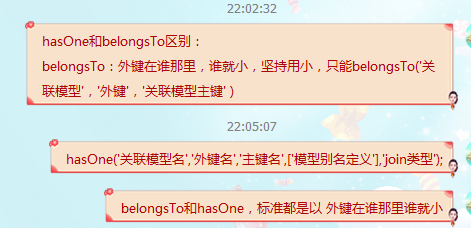1、从字面理解:假如A比B大,那么A hasOne B; B belongsTo A;
2、个人总结:

3、从代码角度:
主要是看你是在哪一个model(模型)中编写这个关联关系,父关联对象就是在父关联model(本文是在Products的model类)下编写的关联模型。
has_one(或has_many):外键在子关联对象中
//父关联对象表
Products{
id
product_name
}
//子关联对象表
Image{
image_id
img_name
product_id //foreign key
}
//hasOne方法的参数包括:
//hasOne('关联模型名','外键名','主键名',['模型别名定义'],'join类型');
//默认的join类型为INNER
//写在Products的model类中
public function Img(){
$this->hasOne('Image','product_id','id');
}
belongs_to:外键在你父联对象中
//父关联对象表:
Product{
product_id
img_id //foreignkey
product_name
}
//子关联对象表
Image{
id
img_name
}
//belongsTo方法的参数包括:
//belongsTo(‘关联模型名’,‘外键名’,‘关联表主键名’,[‘模型别名定义’],‘join类型’);
//默认的join类型为INNER
//写在Products的model类中
public function Img(){
$this->belongsTo('Image','img_id','id');
}
laravel5.4中hasOne和belongsTo、hasMany区分:
/*
* 下面三种写法:第一种会报错(前提:在Admin模型写入users表的模型关系hasOne、belongsTo和hasMany)
* 因为User模型,我们并没有写入position的模型关联方法
* 而Admin::XX 和new Admin 不报错,因为写入了position方法
*/
$users = new AppAdmin();
$uuu = User::find($this->user_id)->position->pos_name;
var_dump($uuu);
$users = new AppAdmin();
$uuu = $users::find($this->user_id)->position->pos_name;
var_dump($uuu);
$uuu = Admin::find($this->user_id)->department->dep_name;
var_dump($uuu);
//依据一个部门只能属于一个公司,而一个部门却可以有多个user,gogo
//$company_msg = Department::find(2)->company->company_name; //【一对一】、【多对一】 这种是正确的,别动了 $usernames = Department::find(6)->user() ->where('is_del','<>','1') ->pluck('username'); //一对多关系 $username_arr = []; foreach($usernames as $v){ $username_arr[] = $v; //输出纯一维数组 } var_dump($usernames); echo "<br>"; var_dump($username_arr);